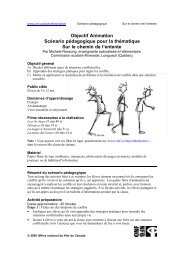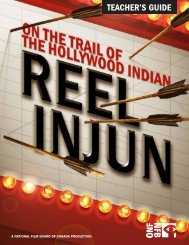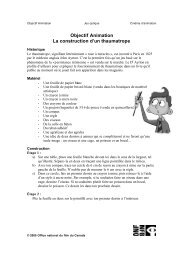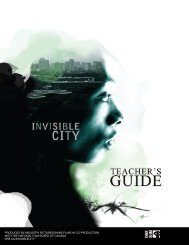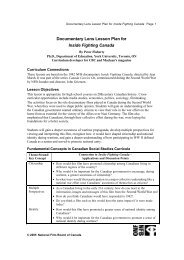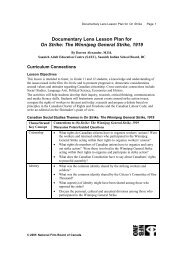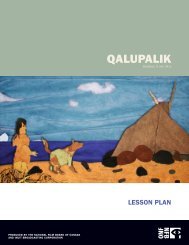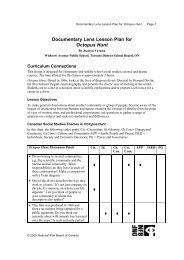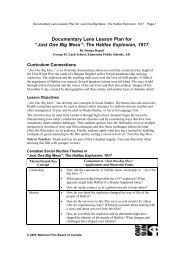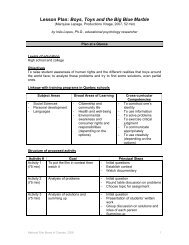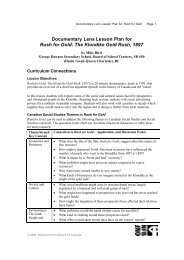Study guide - Office national du film du Canada
Study guide - Office national du film du Canada
Study guide - Office national du film du Canada
- No tags were found...
You also want an ePaper? Increase the reach of your titles
YUMPU automatically turns print PDFs into web optimized ePapers that Google loves.
STUDY GUIDEABOUT THIS APPAvailable for free via the app store, The Loxleys and the War of 1812 isan interactive application targeted at teens. Created by the NFB Digital Studio,and pro<strong>du</strong>ced by the National Film Board in partnership with the Departmentof Canadian Heritage, the app is based on Renegade Arts’ visually compellingand well-researched new graphic novel by the same name. The animated interactivenarrative, which is available in both official languages, concerns a fictionalfamily caught in the very real turmoil of war. It offers an exciting historylesson exploring the causes of the War and the impact of its events on English,French and First Nations people in <strong>Canada</strong> as well as on Americans. The appalso includes an interactive map, which reflects the location of events as usersread along. An active, portable teaching tool, The Loxleys and the Warof 1812 offers a fresh way to give students an overview of the War of 1812.ABOUT THIS GUIDEThe NFB encourages the integration of new technologies in the classroom,and this <strong>guide</strong> is intended to assist secondary school teachers in utilizing theapp to its full e<strong>du</strong>cational potential. The Loxleys and the War of 1812app explores the War via an engaging and interactive platform that allows studentsto visualize events in the conflict and invest in the history. The discussionquestions included in this document serve as a starting point for e<strong>du</strong>catorsand students to consider the events and all of the parties impacted by the War.The activities are designed to stimulate the historical imagination and to fullyimmerse students in the past by recreating events from the conflict.RECOMMENDED AGEThe Loxleys and the War of 1812 is suitable for students aged 13 to19. Its e<strong>du</strong>cational focus corresponds best with American History 11 and CanadianHistory 12 courses, which include the War of 1812 in their curriculum<strong>guide</strong>lines. The app contains graphic scenes of violence. It is recommendedthat e<strong>du</strong>cators preview the app prior to using it in the classroom.RECOMMENDED SUBJECT AREAS★ History★ Aboriginal Studies★ Women’s Studies★ Media Literacy★ Geography★ Family Studies★ Social Sciences★ Visual ArtsKEY THEMES AND CONCEPTS★ Nationalism★ Racism★ Citizenship and Civic Values★ Conflict★ Decision Making★ Ethnocentrism★ Family★ Imperialism★ Power★ RevolutionPRE-VIEWING ACTIVITYPrior to intro<strong>du</strong>cing the app, divide the class into small groups and ask themto research the following events and people from the War of 1812 online: theBattle of Tippecanoe; the Declaration of War in 1812; the Fall of Fort Detroit;the Battle of Queenston Heights; the Battle of Frenchtown/the River RaisinMassacre; the Battle of Fort York; the Battle of Chateauguay; the Battle ofPlattsburg; the Ghent Treaty; the Battle of New Orleans; Indian Confederacy;Chief Tecumseh; Laura Secord; and Sir Isaac Brock. Reconvene the class andask the groups to organize themselves in chronological order using the website1812timeline.com before presenting the information they have gathered.This exercise will help students to contextualize the events from the comicbook featured in the app.AN OVERVIEW OF THE LOXLEYS ANDTHE WAR OF 1812When war is declared, the Loxleys, Loyalist transplants from Pennsylvania, areliving peacefully near Queenston. The family’s father, Aaron “Pa” Loxley, enlistsimmediately, as does his eldest son, Matthew, and his French Canadianson-in-law, Pierre.The Loxley men take part in the important Battle of Queenston Heights wherethey witness the death of Sir Isaac Brock. They subsequently participatein several other key battles and relay news of the front to their loved ones athome through letters and much-anticipated visits.The story sets the military exploits of the men against the domestic hardshipsfaced by the women and children. When American looters decimate the familyhomestead, the grandmother, Aurora Loxley, dies of a heart attack. Herdaughter-in-law, Eliza, takes up the task of keeping her journal. As a resultof this incident, the younger Loxley son runs away in search of the front lines.While the narrative centres upon the anglophone Loxleys, there is also astrong focus on the role of the French Canadian Voltigeurs and the First Nationswarriors. The rise of Tecumseh, his alliance with Britain and his quest foran Indigenous Confederacy are detailed mainly through the eyes of Firebrand,a young Native orphan who lost his father at the Battle of Prophetstown.The narrative is also balanced with regard to the portrayal of the twoprimary factions and emphasis is placed upon the point that “no side hasthe monopoly on atrocity.” The Canadian Green Tigers summarily execute— 2 —
STUDY GUIDEAmerican renegades; British troops turn a blind eye while their First Nationsallies kill American settlers at the Raisin River settlement; and thatevent is later given nuance by Firebrand’s account of why his people aresometimes driven to violence.Throughout the narrative, the experiences of the Loxleys are contextualizedwithin the broader events of the War: the American attacks on Fort York andFort George, the razing of the town of Newark and the retaliatory Britishmarch south to burn the White House.When the War draws to a close, the Treaty of Ghent has been signed, but notbefore the Battle of New Orleans has taken its sad toll. The Loxley family isscarred but unbroken, and life returns to normal. The larger lessons conveyedby the narrative are that war costs and that the clamouring of nations alwaysthreatens the lives of common people.ABOUT THE MAJOR PLAYERSMAJOR-GENERAL SIR ISAAC BROCKSir Isaac Brock was an ambitious young British general with a reputation forrecklessness. He once stated that “nothing should be impossible to a soldier”and, by most accounts, he lived by that motto. Chafing under the cautiousdirective of his superior, Sir George Prevost, that no “offensive operations”be undertaken against the Americans, Brock threw himself into the task ofstrengthening defences at British outposts along the border while waiting forthe Americans to make the first move. On July 12, 1812, American GeneralWilliam Hull invaded the French Canadian town of Sandwich, but was repelledback to Fort Detroit by the Shawnee Chief Tecumseh and his followers.Impressed by Tecumseh, Brock formed an alliance with him and successfullyattacked Fort Detroit. This “bloodless victory” left Britain in control of the UpperCanadian frontier. Brock subsequently led Canadian soldiers and militiato several important early victories, but was killed at the Battle of QueenstonHeights on October 13, 1812.LIEUTENANT JAMES FITZGIBBONIn the class-conscious British Army of the late 1700s and early 1800s, JamesFitzGibbon was something of a rarity. He rose from the rank of Private to thatof Colonel through a combination of luck, canny intelligence and determination.After the War broke out, Lieutenant FitzGibbon distinguished himself byescorting supplies down the St. Lawrence River, right past American troops.The following winter he escorted 45 sleighs from Montreal to Kingston. Hetook part in the Battle of Stoney Creek as a company commander of the 49thRegiment. FitzGibbon subsequently formed a guerrilla-style unit—known asthe Bloody Boys or Green Tigers for their grey green uniforms and their fiercenessin combat—to disrupt American communications and fend off Americanrenegades who were looting and burning farms. Tired of the successes of theBloody Boys, the Americans sent an expedition to attack FitzGibbon near theindigenous settlement of Beaver Dams. Warned of the attack by Laura Secord,FitzGibbon set a detachment of 300 Cognawaga and 100 Mohawk Indians inambush and held Beaver Dams. In the end, he paroled the militiamen and tooka total of 462 American soldiers as prisoners. He was subsequently promotedto Captain in the Glengarry Fencibles until the end of the War. He became aLieutenant-Colonel of Militia in 1821 and a Colonel in 1826.LAURA SECORDBorn in Great Barrington, Massachusetts, Laura Secord—née Laura Ingersoll—moved to Upper <strong>Canada</strong> with her family in 1795. In 1797, she married JamesSecord and settled in Queenston. When a group of invading American soldiers—including American Colonel Charles Boerstler—invited themselves to dinner inLaura’s home, she overheard their plans to launch a surprise attack on FitzGibbonand his fort at Beaver Dams. As her husband had been wounded in battle, it wasLaura who hiked more than 30 kilometres in the middle of the night to warnFitzGibbon. As a result, FitzGibbon was able to defend the Fort. Though she isnow widely recognized as a heroine in the War of 1812, Secord did not receiveany significant recognition for her bravery until she was 85 years old. FitzGibbondidn’t even mention her in his original report.MAJOR CHARLES-MICHEL D’IRUMBERRY DE SALABERRYLieutenant Colonel Charles-Michel d’Irumberry de Salaberry was an upper-classFrench Canadian from a military family. He was an officer of the British army whodistinguished himself by repelling the American advance on Montreal <strong>du</strong>ring theWar of 1812. His specially trained unit, Les Voltigeurs, took part in the Battle ofChrysler’s Farm, described by some as the battle that “saved <strong>Canada</strong>.” But hisgreatest victory took place at the Battle of Chateauguay. De Salaberry’s militaryheritage was reflected in his strict code of discipline and honour. The professionalismand high expectations he held for his fellow Canadiens was repaid by therespect and loyalty of his troops. After the War of 1812, de Salaberry was seen as ahero in French <strong>Canada</strong>. He served as justice of the peace for various district courtsand became a legislative councillor for Lower <strong>Canada</strong>. In 1817, he was made aCompanion of the Order of Bath.LES VOLTIGEURSThe Canadian Voltigeurs were technically militia, but were trained and listed asa regular unit <strong>du</strong>ring the War. They were made up of French-speaking volunteersselected from the militia by Lieutenant-Colonel Charles de Salaberry in 1812, andtrained to a high standard. They wore distinctive grey uniforms (rifle green for officers),and took part in several actions including the Battle of Chateauguay.TECUMSEH, SHAWNEE WAR CHIEFMore than a great warrior, Shawnee Chief Tecumseh was also a skilled negotiatorand a respected source of wisdom and kindness. Prior to the War of 1812,and even as the War broke out, Tecumseh championed the Federation of NativePeoples in an effort to prevent the selling of Indian land to America withoutthe consent of all the Indian elders across the concerned tribes. Support forthe movement was lukewarm at best and, despite numerous discussions withAmerican Governor William Henry Harrison, Tecumseh accomplished little. InJuly 1811, he left discussions with Harrison and travelled south to bring thepossibility of a federation to the Indians there. While he was gone, his homesettlement at Tippecanoe was left without its leader. Governor Harrison tookadvantage of this opportunity to launch an attack and, he hoped, provoke theShawnee into some rash action that would “justify” their extermination. WhenTecumseh returned from the south, he found Tippecanoe destroyed. It was thisact of war that finally unified many of the Indian tribes under Tecumseh. Hewent on to gain the respect of Britain’s Major-General Isaac Brock in the Battleof Fort Malden. About Tecumseh, Brock wrote: “A more sagacious or a moregallant Warrior does not, I believe, exist.” Later, fighting alongside Major-General Henry Procter in the Battle of Fort Meigs, Tecumseh and his warriorsovertook the American reinforcements that would elsewise have tipped thebalance of the conflict. Finally, on October 5, 1813, Tecumseh was killed whenhe and a small group of Indian warriors chose to defend British lines whenmost other soldiers, including the British themselves, had fled.— 3 —
STUDY GUIDEFEDERATION OF NATIVE PEOPLESBuilt on the teachings of the Shawnee “Prophet” Lalawethika, Chief Tecumseh’sbrother, the Federation of Native Peoples sought to stop the selling of Indianland to America before and <strong>du</strong>ring the War of 1812. Though its memberswere mostly Shawnee, its leader, Chief Tecumseh, held influence in most nativenations throughout the northwestern United States. As a result, he was ableto recruit members from tribes including the Iroquois, Chickamauga, Ojibway,Mascouten and Potawatomi. However, gaining support was often difficult.Tecumseh’s proposed unification of all Indian nations would undermine theauthority of indivi<strong>du</strong>al chiefs and elders. Many nations and tribes felt themselvesto be on better terms with the Americans and allied with them againstthe Federation. Chief Black Hoof, also Shawnee, was a staunch opponent.Rather than unite with Tecumseh’s cause, Black Hoof urged his people towardcultural adaptation—adoption of the American way of life. At the peak of itsstrength, Tecumseh’s Federation numbered over 5,000 warriors. But with hisdeath in the Battle of the Thames in late 1813, it disintegrated and was neverre-established.ABOUT THE HISTORICAL EVENTSTHE BATTLE OF TIPPECANOE (NOVEMBER 7, 1811)The Battle of Tippecanoe, or “Prophetstown,” took place at a native settlementfounded by Tecumseh and his younger brother, the “Prophet” Lalawethika, onthe banks of the Wabash River in Indiana Territory. Residents of Tippecanoehad set aside tribal differences in order to work towards an Indian confederacy.By 1811, hundreds had flooded into the village to protest Americanland grabs of traditional territory, and Tecumseh had turned to the British forsupplies to feed his rapidly growing community. This enraged Indiana GovernorWilliam Henry Harrison, who resented British involvement and viewed thenatives as a threat to his expansionist policies. Tecumseh was a fierce warrior,but he was not foolhardy and realized the time had not yet come for all-outwar. Instead, he travelled south for a parlay with the Creek Nation, seekingto expand his confederacy. Taking advantage of Tecumseh’s absence, Harrisonplanned a sunrise attack on Tippecanoe for November 7, 1811. News of theplan reached Lalawethika on November 6, however, and he mobilized the500 warriors at Tippecanoe into a pre-dawn ambush. Although the warriorsinflicted heavy casualties, they were ultimately pushed back. Stunned by hislosses however, Harrison went on the defensive, rather than attacking thevillage immediately. By November 8, when an American patrol approachedTippecanoe, it was found abandoned. Harrison ordered the village burned andthe granary plundered. In the spring of 1812, Tecumseh returned and, standing“upon the ashes of [his] home,” he “summoned the spirits of the braveswho had fallen in their vain attempts to protect their homes from the graspinginvader.” This battle left him little choice but to ally himself with Britain in thecoming war. For his part, Harrison called for vengeance through congressmenlike Henry Clay and Felix Grundy, who used Tippecanoe as a rallying cry forwar against Britain.AMERICAN DECLARATION OF WAR (JUNE 18, 1812)One of the most memorable statements—at least among Canadians—onthe subject of America’s declaration of war against the British Empire camefrom Thomas Jefferson: “The conquest of the <strong>Canada</strong>s will be a mere matterof marching.” With most of Britain’s trained soldiers already fighting Napoleonin France, much of the American invading force believed <strong>Canada</strong> to belargely undefended and thus easily overtaken. So, fuelled by the near-religiousconviction of America’s “Manifest Destiny” and Senator Henry Clay’s publicoutrage over the British impressment of American citizens, America went towar in <strong>Canada</strong>. Conquest proved less straightforward than those in powerhad anticipated, however. The sheer size of <strong>Canada</strong> made the question ofwhere to begin marching (and how to distribute forces) difficult to answer. TheAmericans also did not anticipate such a large and willing contingent of Indianfighters and Canadian militiamen.GENERAL WILLIAM HULL INVADES SANDWICH (JULY 12, 1812)By 1812, most of the American public agreed with former President ThomasJefferson that invading the <strong>Canada</strong>s would be “a mere matter of marching.”It had been decided that a primary contingent would advance on Montreal, asecond would push up the Niagara River and a third would sweep out of FortDetroit into the heart of Upper <strong>Canada</strong>. Michigan Territory Governor WilliamHull, who was stationed at Fort Detroit, was in charge of the Upper <strong>Canada</strong>campaign. Hull had little enthusiasm for his command and botched several aspectsof his campaign. The British uncovered his entire invasion plan and capturedmany of his army’s supplies when they took command of the Americanschooner Cayuga, depriving Hull of the element of surprise. He did manageto cross the Detroit River and temporarily occupy the French Canadian villageof Sandwich. Fearing the natives would attack, Hull sent fiery missives to thewhite settlers around Sandwich, threatening to kill any who sided with theIndians. Hull’s worst fears were realized when Tecumseh and a raiding partyambushed a supply column on its way to Fort Detroit on August 5, 1812. Threedays later, Hull ordered Sandwich abandoned and withdrew his army behindthe walls of Fort Detroit.THE ATTACK ON FORT DETROIT (AUGUST 16, 1812)Major-General Isaac Brock’s attack on Fort Detroit is the stuff of legend. Outmannedand outgunned, the first British attempt to take the Fort had beenessentially useless. Then, with the arrival of Shawnee Indian Chief Tecumsehand several hundred of his warriors, the scales began to tip and Brock had anidea: he ordered his trained soldiers to share their uniforms with the regularmilitiamen; marching them back and forth out of firing range, he made itseem that his forces were twice as large. Then, Tecumseh did the same withhis warriors, making sure that American General William Hull got a good lookat the numbers. Finally, Brock gave Hull three hours to surrender the Fort. Hullfell for the trick and surrendered Fort Detroit with no loss of life on either side.QUEENSTON HEIGHTS (OCTOBER 13, 1812)Queenston Heights had sprung up as a waypoint where boats could unloadcargo to be transported throughout Niagara Falls by horse and cart. Becauseof its significance in the movement of supplies, attacking Queenston wouldeffectively cut Lower <strong>Canada</strong> and Upper <strong>Canada</strong> off from one another. TheAmericans attempted to gain ground on the Canadian side of the Niagara butultimately failed <strong>du</strong>e to a highly disorganized campaign and quarreling Americanleadership. The Canadians were led by Major-General Isaac Brock after hisvictorious return from Fort Detroit. Brock was awakened by American artilleryfire and rushed towards Queenston Heights while gathering his troops. Asthey climbed the steep slope of the heights towards the Americans, they weremet with fire, and Brock was hit in the wrist by a musket ball. With his swordheld high, Brock continued to move his troops towards the Americans; but asthey charged forward, Brock was hit again, this time just above the heart, anddied. With Brock’s death, Major General Roger Sheaffe took charge, and histroops continued to lunge at the Americans. The British and Canadians wereoutnumbered, but a strong British artillery and demoralized American soldiers,unwilling to fight on foreign land, led to the surrender of the Americans and adecisive and important victory for the British and Canadians.— 4 —
STUDY GUIDEBATTLE OF CHATEAUGUAY (OCTOBER 26, 1813)In October 1813, de Salaberry’s Voltigeurs intercepted American troops whowere advancing on Montreal under General Wade Hampton. De Salaberry reliedon reports from local farmers to keep track of Hampton’s manoeuvres, settraps of fallen trees and tangled brush called “abattis” to slow them down asthey approached the Chateauguay River and then hid his own troops in thewoods. On October 26, 250 Voltigeurs plus 50 allied warriors of the KaunawakeeMohawk nation led the advance against Hampton’s force of 4,000 troopsand 10 cannons. The rest of de Salaberry’s 1,500 men remained in reserveas Hampton’s troops approached the barricades that evening. De Salaberryordered bugles to be blown from several locations to convince the Americansthey were surrounded. Les Voltigeurs then fired their rifles, inflicting numerouscasualties. Unable to outflank de Salaberry’s forces, Hampton withdrew to theAmerican border.THE BURNING OF WASHINGTON (AUGUST 24, 1814)In August of 1814, British Major General Robert Ross entered Chesapeake Baywith 4,000 men, and the intention to take both Washington and Baltimore.Though his troops came up against 7,000 Americans, only 1,000 were enlistedsoldiers. At the time, American forces believed that neither Washingtonnor Baltimore could ever be seriously threatened. Ross’s troops scattered the6,000 American militiamen by firing a volley of flaming Congreve rockets overtheir heads. The remaining 1,000 soldiers were easily confronted. Interestingly,Ross was under orders to burn Washington, but only its government buildings(including the White House). He himself ordered the burning of the office ofthe National Intelligencer, a paper that had featured articles scorning him in anumber of its issues. However, after several citizens protested on the groundsthat the fire might spread to nearby homes, Ross settled for smashing theprinting press and the destruction of thousands of tonnes of military stores.THE TREATY OF GHENT (DECEMBER 24, 1814)In August of 1814, eight commissioners representing both British and Americaninterests gathered in Ghent, Belgium. The discussions that would eventuallyend the War began poorly and participants made little progress untilDecember of that year. Initially, neither side was willing to make any concessions.The British refused to abolish impressment. They demanded that theAmericans destroy any forts on the southern shores of the Great Lakes andend any naval presence there. The greatest point of contention, however, wasthe British insistence that an Indian territory be established in the West. Neitherthe British, nor the Americans would be allowed to violate this territoryby conquest, purchase, negotiation or any other means. The Americans wereradically opposed to the proposal; they remained committed to coast-to-coastexpansion. The idea of “savage” Indians, who had “no concept of land ownership,”having any weight in negotiations was unheard of. Both sides consideredthe talks doomed to fail, until John Quincy Adams noted that the onlyway to restore peace was to return all borders and land holdings to the waythey had been—to “conclude on the footing of the state before the war.”Europe was at peace, so impressment was no longer an issue. With both sidessuffering under wartime losses, all other concerns would be set aside for laterdiscussion, with the exception of the matter of an Indian state. On this, theBritish relented and their indigenous allies were abandoned in what CommissionerHenry Goulburn thought was one of the greatest betrayals of the War.THE BATTLE OF NEW ORLEANS (JANUARY 8, 1815)Though the Treaty of Ghent effectively ended the War on Christmas Eve of1814, it took until mid-February of the following year for news of peace toreach North America. Meanwhile, the War ground on and Major-General SirEdward Pakenham led 4,400 British soldiers to face the Americans in NewOrleans. After a month-long trek through bayous and swampland, the Britishwere decimated, despite the fact that the American forces were mostly volunteers,freed slaves and pirates. The conflict claimed the lives of 291 soldiers,including Major-General Pakenham; 1,262 were wounded, and 484 wentmissing. It was the largest, bloodiest, and most pointless British loss in a warthat had, effectively, already ended.DISCUSSION QUESTIONS FORSTUDENTS AGED 13 TO 191 What have you learned about the War of 1812?2 Why do you think it is important to study the War of 1812 in <strong>Canada</strong>?3 What were the main issues that led President Madison to declarewar on Great Britain?4 What was impressment? Why was impressment used <strong>du</strong>ring the Warof 1812?5 Who are the heroes in The Loxleys and the War of 1812?Why?6 The War of 1812 typically is seen as a battle between the Americansand the British while the First Nations perspective is overlooked.What were the consequences of the War on the First Nations peopleof America and <strong>Canada</strong>? What unique First Nations perspectives arereflected in the The Loxleys and the War of 1812?7 Why did Chief Tecumseh hope to form a confederacy with otherindigenous tribes in North America? What would the Federation ofNative Peoples have meant for the First Nations involved? Why didthe Americans see this as a threat?8 Shortly after the scene in the graphic novel in which George andFirebrand witness speared and staked “enemies,” Firebrand explainswhy his people are sometimes driven to violence. What does hemean by this? Can you think of present day examples in whichpeople are driven to violence to protect their homes?9 Women played significant parts <strong>du</strong>ring the War of 1812. Discuss thevarious roles women play in the The Loxleys and the War of 1812.10 Who was Laura Secord? Discuss her contribution to the War of 1812.11 Why is it important to Pa Loxley, Matthew and Pierre to join the waragainst the Americans? Given their motivations, do you think theyshould have gone to war? If yes, why? If no, why not?12 How would you feel if your parents decided to fight for <strong>Canada</strong> in awar and there was a possibility of their never coming home?13 Discuss the consequences of the War of 1812. What were the mosttragic events?14 Who won the War of 1812? What did they gain?15 Who lost the War of 1812? What did they lose?16 Why do you think the War of 1812 is sometimes called“the Forgotten War”?— 5 —
STUDY GUIDECLASSROOM ACTIVITIESWRITE A SCRIPT AND RE-ENACT THE EVENTHave students work in small groups to write a short script about the Battleof Tippecanoe or another major topic related to the War of 1812. Begin byresearching the event, the dates, the locations and the people who were involved.Have students consider diverse aspects of the War by writing from theperspective of a First Nations family, or from another point-of-view that is usuallyoverlooked in history textbooks. Discuss the overall plot structure of thescript. Does it have a beginning, middle and end? How many scenes will therebe in the script and how much dialogue will be used? Encourage students tocontinuously assess whether their script is accurately representing the event.Conclude the activity by having the groups perform one of the scenes theywrote, or trading scripts and presenting another group’s scene.ADDITIONAL SCRIPT TOPICS COULD INCLUDE:★ The American Declaration of War in 1812★ The Battle of Queenston Heights★ The Fall of Fort Detroit★ The Battle of York★ Laura Secord★ Chief Tecumseh and the Federation of Native Peoples★ The Treaty of GhentCREATE A SERIES OF TABLEAUX AND NARRATE THE EVENTA tableau is a “freeze frame” or a still picture created by people posing torepresent a moment in time. For this activity, form small groups and ask eachgroup to research an event from the War of 1812. (For examples, consider thelist in the previous activity.) Drawing on their research, groups will create fivetableaux about the event, showing how it began and continuing through toits outcome. The students will also compose a descriptive narration to go witheach tableau.After each group presents its tableaux, discuss the event that was portrayed,why the event was important to the War of 1812 and whether the tableauxoffered an accurate representation of the event or made use of fictional elements/characters.Finally, ask your students what they learned from the activity.CREATE A HERITAGE HISTORY MINUTEThe Heritage Minute program was developed by the Historica-Dominion Instituteof <strong>Canada</strong> in 1991 to promote Canadian history and to e<strong>du</strong>cate Canadiansabout the stories that make our country unique. Heritage Minute videosare similar to TV commercials in length; these brief vignettes tend to includethe setting, the date, the events, the people involved and finally the historicalsignificance of the event or indivi<strong>du</strong>als portrayed. Ask students to createtheir own Heritage Minute using this structure as a template and stop-motionanimation technique.1 Working in small groups, they should create a storyboard and a shortscript about a person or event from the War of 1812.2 Have groups create sets and props using cardboard and constructionpaper, and sculpt characters using modelling clay.3 Download the NFB’s free stop-motion app PixStop onto youriPad via iTunes.4 NFB E<strong>du</strong>cation’s StopMo site provides instruction on stop-motionanimation. View it here: nfb.ca/playlist/stopmostudio/The following URL links to the Heritage Minute about Laura Secord:historica-dominion.ca/content/heritage-minutes/laura-secord?media_type=41&CREATE A POWERPOINT MEMOIRInstruct students to research the life of a significant figure from the War of1812, including detailing that person’s biographical information, their relationshipswith others, what impact they had on the War and how the conflictchanged their lives. Students will then write a short memoir of the personthey have researched and collect approximately 10 images from the Internetthat would serve to accompany the memoir text. With the text and images inhand, instruct the students to create a PowerPoint file, import the images andarrange them as a memoir. As a final step, they may elect to add backgroundmusic. Have the class present their PowerPoint memoirs by reading aloud thetext that they have written while scrolling through the images.CREATE A ZINEA zine is a self-published mini-magazine or comic book, and may be the resultof the work of one person or several collaborators. A standard zine format is8.5” by 11” paper folded in half, but they can be smaller or larger. Instructstudents to make their own zines about the War of 1812, either working indivi<strong>du</strong>allyor in groups. The finished pro<strong>du</strong>cts could include (for instance): diaryentries by Firebrand; obituaries of key people involved in the War of 1812;propaganda advertising; a recipe from Aurora Loxley’s kitchen; a newspaperclipping about the Declaration of War; an interview with Chief Tecumseh; acomic strip about Laura Secord; a poem about the Battle of Tippecanoe; areview of The Loxleys and the War of 1812; etc.— 6 —
STUDY GUIDEMEDIA LITERACYWhen considering media representations based upon historical events, it is importantto examine how the facts are interpreted and presented, and whetherdivergent interpretations or sources exist. Films, comic books and even classroomtextbooks, for instance, may be based upon extensive primary-source research,which is then presented in new formats; these new mediums are thussecondary sources that are interpretations of the past. Students researchinghistorical events and consulting secondary sources should consider whether atext might be exaggerated or biased and become familiar with referring to primarysources of information if they believe the situation requires it. Questionsto be asked when evaluating an information source include: who/what is thesource and whether the source represents first-hand knowledge of events oran interpretation after the fact. Proper care must be taken when researchingthe past to avoid creating a false or inaccurate account of events or completelyomitting a part of our history.Primary sources are documents or objects that were written or created <strong>du</strong>ringthe time in question, by those who experienced the event or conditions at thattime. Examples of primary sources are:★ Diaries★ Speeches★ Manuscripts★ Letters★ Interviews★News <strong>film</strong> footage★ Official records★ Poetry★ Music★ Art★ Pottery★ Furniture★ Clothing★ BuildingsQUESTIONS FOR FURTHER DISCUSSION1 Why do you think it is important to study historical events such asthe War of 1812?2 Who created the comic book The Loxleys and the War of1812? Why do you think they created it?3 Whose perspective is the War of 1812 described from in the book/the app? Why do you think the author chose to tell the story fromthis perspective?4 How might this story be different if it were told from the perspectiveof the First Nations People?5 Are there ways to ensure a balanced representation of events whendocumenting history? What are indications of a balanced representation?6 What is the value in updating history books and re-telling storiesfrom the past in new forms?7 Can you identify any visual stereotypes in this story? If so, what arethey? What do you define as stereotypes?8 How are Americans presented in this story?9 How does the artist depict scenes of war? How does the artist depictscenes of home life?Secondary sources are documents or objects that are interpretations of primarysources and are created by those who have second-hand experiencewith the event or time period. Examples of secondary sources are:★ Textbooks★ Magazine articles★ Histories★ Criticisms★ Commentaries★ Encyclopaedias★ Historical fiction★ Films based upon historical eventsFor more information on primary and secondary sources, follow this link:collectionscanada.gc.ca/e<strong>du</strong>cation/008-3010-e.htmlMEDIA LITERACY ACTIVITYAsk students to read the essay by Darren Bonaparte, an Aboriginal historian,which is appended to this <strong>guide</strong>. As a class, discuss the thesis of his essay.What can we learn about our <strong>national</strong> history from Aboriginal historians?— 7 —
STUDY GUIDEVISUAL TECHNIQUESArtists use diverse visual techniques to convey messages, evoke emotions,heighten tension or create a mood. As such, the use of visual techniques isa means of enhancing the experience of the viewer/reader but it can also beseen as a way of manipulating the viewer/reader into feeling a certain wayabout the story’s events. Consider and discuss the various visual techniquesused by the artists in The Loxleys and the War of 1812. Look at how theartist frames each character and the action in the panels throughout the story.Is the panel using an eighth of the page or the whole page? When does theartist use a close-up image of the character? How do these visual techniquesimpact your overall experience of the story?AESTHETICIZING VIOLENCEViolence is often depicted as a striking or beautiful image or moving sequencein <strong>film</strong>s, comic books and other forms of visual media. Discuss with your classwhether there are any scenes in The Loxleys and the War of 1812 thataestheticize violence and, if so, which scenes do so. Further questions: Canstudents refer to other current examples of the aestheticizing of violence in<strong>film</strong>, television, comic books, games or newspapers? What do students thinkare some issues surrounding aestheticizing of images of war?COMIC BOOK TERMINOLOGYLearning the language of comic books allows readers to understand, analyze,evaluate and critique the information being presented to them; it alsoempowers them to create their own message using the medium. All art formshave a language, but the languages of the visual arts often cross-pollinate.For example, <strong>film</strong> might use framing techniques that you would find inthe panels of a comic book. The following overview of basic comic bookterminology (derived from Wikipedia) will help students understand visualtechniques that are typically employed in comic books.★ Panels: Panels are images that are laid out within the page borders.The most traditional layout for comic books is a grid of nine panels, ina three-by-three format.★ Panel frames: The border or edges of a panel are called frames.Traditionally, these are rectangular in shape but can be altered by theartist.★ Bleed: A bleed is when the art runs to the edge of each page anddoes not have a white border around the image. This is most commonlyseen on the front cover.★ Splash page: A splash page is a full-page drawing in a comic book.A splash page is used when the artist wants to highlight an importantevent or element in the story. When the image appears across twopages of the comic book, it is called a double splash page.★ Speech balloon or speech bubble: Speech balloons are agraphic used to assign ownership of dialogue to a particular character.These may vary in shape depending on the type of dialogue that itcontains: for example, whispers are often represented using brokenlines, screaming tends to be conveyed though spiky lines and cloudlikeshapes denote interior thoughts.★ Captions: Captions are a narrative device used to communicateinformation that cannot be communicated by the speech balloon. Theycan be used in place of thought bubbles, and can be composed in thefirst, second or third person.★ Motion lines: Motion lines are used to indicate that a characteror object is moving.★ Gutter: Gutter is the space between the borders.— 8 —
STUDY GUIDERELATED NFB FILMSTHE WAR OF 1812★ War of 1812 – Part One: “When I Meet My Doom…”1998, 46 minutes★ War of 1812 – Part Two: “Or Leave Our Bones Upon Them…”1998, 46 minutes★ War of 1812 – Part Three: “So Awful a Night…”1998, 46 minutes★ War of 1812 – Part Four: “The Rocket’s Red Glare…”1998, 46 minutes★ The Battle of the Chateauguay1978, 30 minutes★ <strong>Canada</strong> and the American Revolution1967, 57 minutes★ A Question of Identity: War of 18121966, 28 minutes★ The Story of H.M.S. Shannon1958, 8 minutesADDITIONAL RESOURCES★ Zuehlke, Mark. For Honour’s Sake: The War of 1812 and the Brokering ofan Uneasy Peace. Toronto, Ontario: Random House, 2007. Hardcover.★ The Government of <strong>Canada</strong> – War of 1812 site:1812.gc.ca/eng/1305654894724/1305655293741★ The Archives of Ontario – War of 1812 virtual exhibit:archives.gov.on.ca/english/on-line-exhibits/1812/index.aspx★ The Historica-Dominion Institute, the Royal Canadian GeographicalSociety and Parks <strong>Canada</strong> – War of 1812 site: eighteentwelve.ca/★ The Historica-Dominion Institute, the Royal Canadian GeographicalSociety and Parks <strong>Canada</strong> – First Nations and the War of 1812 topicsite: eighteentwelve.ca/?q=eng/Topic/9★ Renegade Arts Entertainment – War of 1812 timeline:1812timeline.com/★ Renegade Arts Entertainment – About the creators of The Loxleysand the War of 1812: renegadeartsentertainment.com/comics-about★ Wikipedia – Comics Vocabulary:en.wikipedia.org/wiki/Comics_vocabularyABORIGINAL STUDIES★ Is the Crown at War with Us?2002, 96 minutes★ Kanata: Legacy of the Children1999, 52 minutes★ Kanehsatake: 270 Years of Resistance1993, 119 minutes★ Dancing Around the Table – Part One1987, 57 minutes★ Dancing Around the Table – Part Two1987, 50 minutes★ Incident at Restigouche1984, 46 minutes★ You Are on Indian Land1969, 37 minutes★ The Ballad of Crowfoot1968, 10 minutesALLEGORIES OF WAR★ Dominoes2006 10 minutes★ Neighbours1952, 8 minutes★ Toys1966, 8 minutes— 9 —
STUDY GUIDEAPPENDIXBEYOND TECUMSEH: ABORIGINAL EXPERIENCE IN THE WAR OF 1812By Darren Bonaparte, Akwesasne First NationThe bicentennial commemoration of the War of 1812 has pro<strong>du</strong>ced variousarguments about who won the War but there is no disputing who lost it: theAboriginal nations.Discussions about the War’s impact on the North American indigenous peoplesinevitably focuses attention on the mercurial Shawnee leader, Tecumseh, andhis pan-Indian alliance. His early victories and eventual defeat at the handsof Americans have come to symbolize the peaks and valleys of the Aboriginalexperience throughout the era of European colonization.Not all natives involved in the War were a part of Tecumseh’s movement. Theirreasons for being drawn into the War were as varied as their experienceswithin it.The Haudenosaunee, also known as the Iroquois Confederacy, are a goodexample of how complicated the War of 1812 would become for First Nations.For them, 1812 was the latest chapter in a centuries-old story that saw theirlegendary confederation unravel under the pressure of competing Europeancolonies. It began with the Dutch and the French in the 17th century, continuedwith the British and French in the French and Indian War, and climaxedwith the British and Americans in the American Revolution. Iroquois warriorsfought on opposite sides in all of these conflicts, suffered great losses, andfound themselves displaced and marginalized in the aftermath.When the War of 1812 broke out, the Iroquois had already experienced centuriesof European colonization. Urged to remain neutral at the outset, Iroquoiswere eventually drawn into the conflict on both sides. Nowhere was this morepronounced than Akwesasne, a Mohawk community bisected by the borderbetween <strong>Canada</strong> and the United States.Oral traditions of the community report that when the border was first drawn,government officials assured the Mohawks that the border was only to keepthe settlers in order and would not apply to them. They could come and go asthey pleased and hunt, trap, fish, farm and trade on either side of the line. TheWar of 1812 changed all of that. Settlers in the region were so terrified of anew “Indian war” that the people of Akwesasne were forbidden to leave thecommunity, forcing them to appeal to outside authorities for food to sustaintheir lives.Long after peace had been restored, the animosities engendered by the Warcontinued to simmer within Akwesasne. American and Canadian governmentstried to divide the community into two separate bands according to their locationon the inter<strong>national</strong> boundary. This went against the earlier promises thatthe border would not apply to Akwesasne, but it has remained the officialpolicy of both governments to this day. In a very real sense, the War of 1812has not ended for Akwesasne. The inter<strong>national</strong> boundary continues to affectthe day-to-day existence of Mohawks in a myriad of ways.Aboriginal historians see the War’s bicentennial commemoration as an opportunityto e<strong>du</strong>cate Americans and Canadians about the unique perspectiveof First Nations. We are the third strand in the braid of North American history,a fact often overlooked today. At the hands of many historians, natives remainfaceless villains hooting and hollering from the forests, striking terror in thehearts of soldiers and settlers alike.The Loxleys and the War of 1812 is one of those rare projects thatallows the native participants to emerge from the shadows and reveals theirhuman dimension. Firebrand, a young native warrior, encounters a Canadianboy of similar age in the forest and befriends him. He takes the boy to his villagewhere he is attired and taught war skills in the Indian fashion. Althoughtheir friendship is short-lived <strong>du</strong>e to the horrors of war, the young Canadiangets to see the conflict from an entirely different perspective.Firebrand’s village is one of those amalgamated communities that ralliedaround Tecumseh. The artist depicts their clothing, hairstyles, weapons, toolsand dwellings as a blend of native and non-native influences that were currentas of 1812. Although the graphic novel format has its inherent limitations,The Loxleys and the War of 1812 effectively illustrates the fusionof technologies and cultures that characterized First Nations communities inthe early 19th century. It also personalizes the tragic circumstances of nativeinvolvement in the War of 1812.While all today remember the name of the mighty warrior Tecumseh, therewere countless other natives who paid the ultimate price in this conflict. Theirnames grace no monuments or memorials, but their lives and sacrifice arecapable of touching each of us today.Both the British and Americans subjected Akwesasne to military occupation.On the American side of the territory, the United States constructed a blockhousefrom which they would attack the Canadian Voyageur outpost acrossthe line. The brief skirmish that ensued in October of 1812 took place in theearly morning hours and was over before the Mohawks were even aware ithad occurred. Not long after, the British retaliated by attacking the Americanblockhouse.Three factions emerged at Akwesasne: the neutral, the pro-American and pro-British. The neutral faction saw no benefit in taking sides with people fightingover native lands. The pro-American faction was led by a chief who held anofficer’s commission in the Continental Army in the American Revolution. Thepro-British faction was led by chiefs who felt an obligation to support GreatBritain as a partner in the Silver Covenant Chain of Peace and Friendship. Sixtyto 80 warriors joined the conflict and helped to block the American invasionsof <strong>Canada</strong> from the Niagara frontier to Chateauguay.— 10 —




